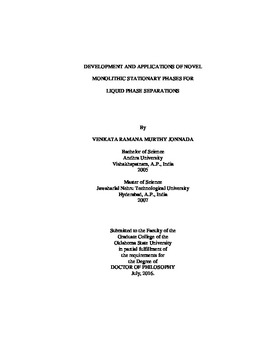| dc.contributor.advisor | El Rassi, Ziad | |
| dc.contributor.author | Jonnada, Venkata Ramana Murthy | |
| dc.date.accessioned | 2017-02-22T22:08:03Z | |
| dc.date.available | 2017-02-22T22:08:03Z | |
| dc.date.issued | 2016-07 | |
| dc.identifier.uri | https://hdl.handle.net/11244/48771 | |
| dc.description.abstract | This dissertation aims at developing novel monolithic stationary phases for HPLC, in which three different materials were fabricated for different modes of separation, such as hydrophilic liquid interaction chromatography (HILIC), bio-affinity and reversed-phase chromatography (RPC). Firstly, for HILIC based separations, zwitterionic monolithic columns were prepared by the functionalization of glycidyl methacrylate based monoliths with various glycine moieties. The applications of this monolithic column were demonstrated in the separation of nucleobases and some highly polar drugs, e.g., catecholamine derivatives. This was followed by the introduction of monolithic micro columns that were prepared in 1mm i.d. stainless steel tubing. It involved the in situ co-polymerization of N-acryloxysuccinimide (NAS) and ethylene glycol dimethacrylate (EDMA) in toluene as the porogen. Through its surface Nhydroxysuccinimide functional groups, the NAS-EDMA monolith allowed the immobilization of n-alkyl amine ligands or protein ligands via the reaction between the primary amines of the ligands and the NAS-EDMA forming stable amide linkages. The utility of NAS-EDMA monolith was assessed in two different immobilizations of proteins. In one immobilization process, 4 different lectins with different affinity to glycoconjugates were immobilized onto the NAS-EDMA monolith, and the 4 resulting lectin columns were arranged in tandem to capture sub-glycoproteomes from healthy and breast cancer sera. In a second approach, a micro-immobilized enzyme reactor consisting of NAS-EDMA monolith with immobilized trypsin was prepared. This enzyme reactor was coupled on line with an octadecyl silica column and its performance was tested with the tryptic map of cytochrome C. In addition, the NAS-EDMA monolith with covalently attached n-octadecyl chains proved useful in RPC protein separations by micro-HPLC. In the aim of furthering the progress of RPC monoliths, a novel organic monolithic column with surface bound naphthyl ligands was prepared and its applications in RPC were investigated. The monolithic column was prepared by in situ co-polymerization of 2- naphthyl methacrylate and trimethylolpropane trimethacrylate and its usefulness was demonstrated in the separation of both small and large molecules. Furthermore, 3 cm short column was prepared for the fast separation of proteins by ultra-steep linear gradients. Finally, oil and meat samples were analyzed for their fatty acid content by a novel fluorescent derivatization strategy, and the separation of the derivatized fatty acids was achieved on both in-house synthesized naphthyl functionalized monolithic column and commercially available silica columns. | |
| dc.format | application/pdf | |
| dc.language | en_US | |
| dc.rights | Copyright is held by the author who has granted the Oklahoma State University Library the non-exclusive right to share this material in its institutional repository. Contact Digital Library Services at lib-dls@okstate.edu or 405-744-9161 for the permission policy on the use, reproduction or distribution of this material. | |
| dc.title | Development and applications of novel monolithic stationary phases for liquid phase separations | |
| dc.contributor.committeeMember | Lavine, Barry K. | |
| dc.contributor.committeeMember | Materer, Nicholas | |
| dc.contributor.committeeMember | Bunce, Richard | |
| dc.contributor.committeeMember | Ramanathan, Ranjith | |
| osu.filename | Jonnada_okstate_0664D_14786.pdf | |
| osu.accesstype | Open Access | |
| dc.type.genre | Dissertation | |
| dc.type.material | Text | |
| thesis.degree.discipline | Chemistry | |
| thesis.degree.grantor | Oklahoma State University | |
